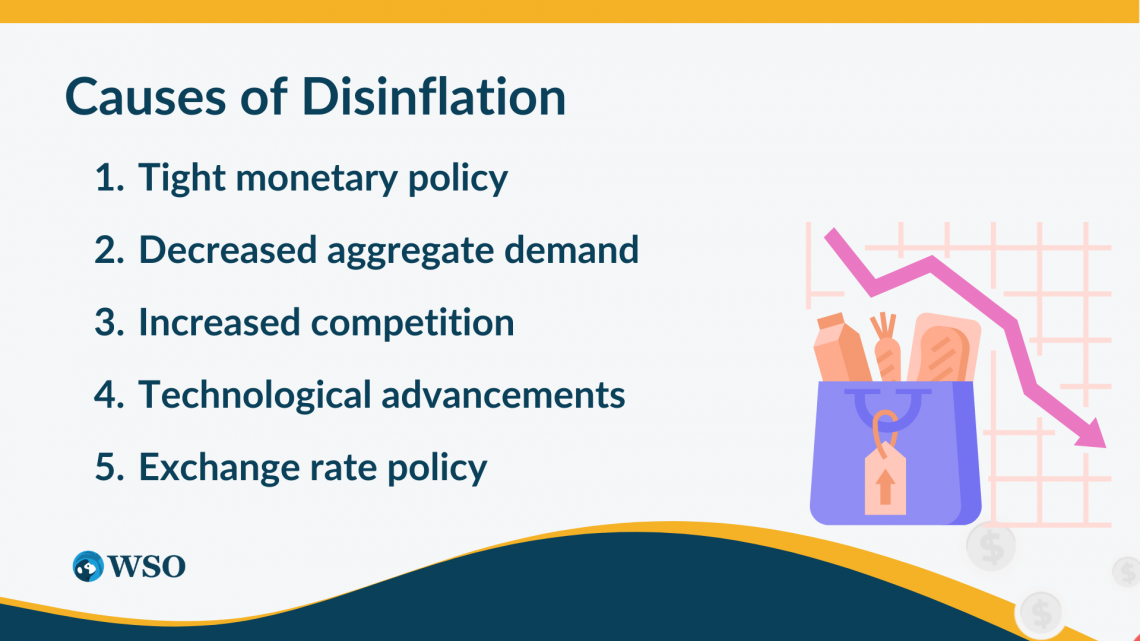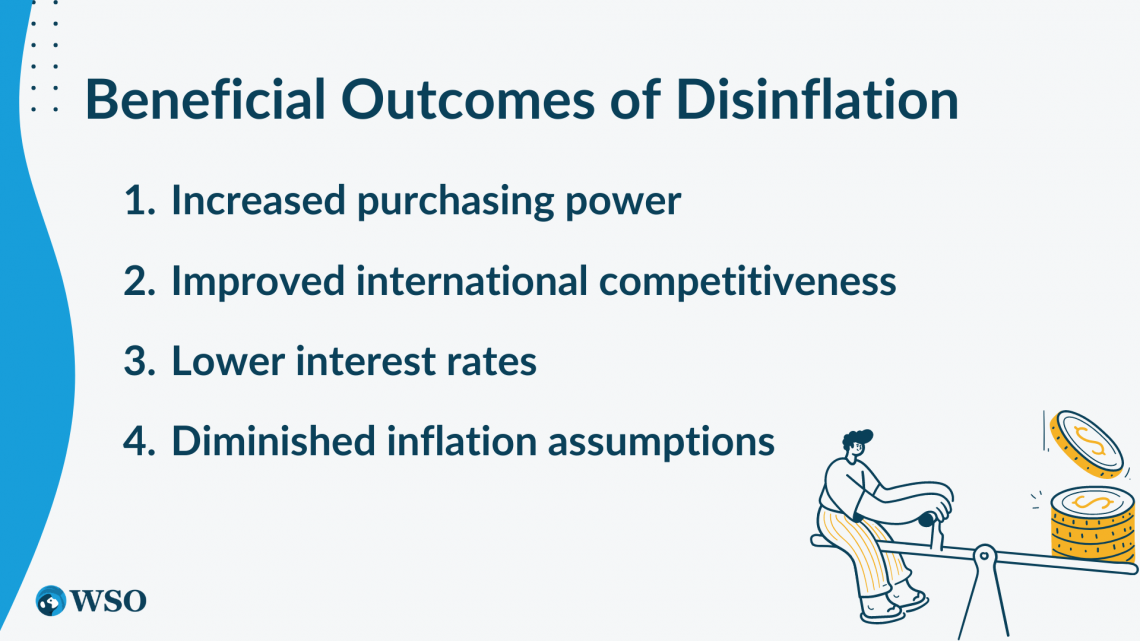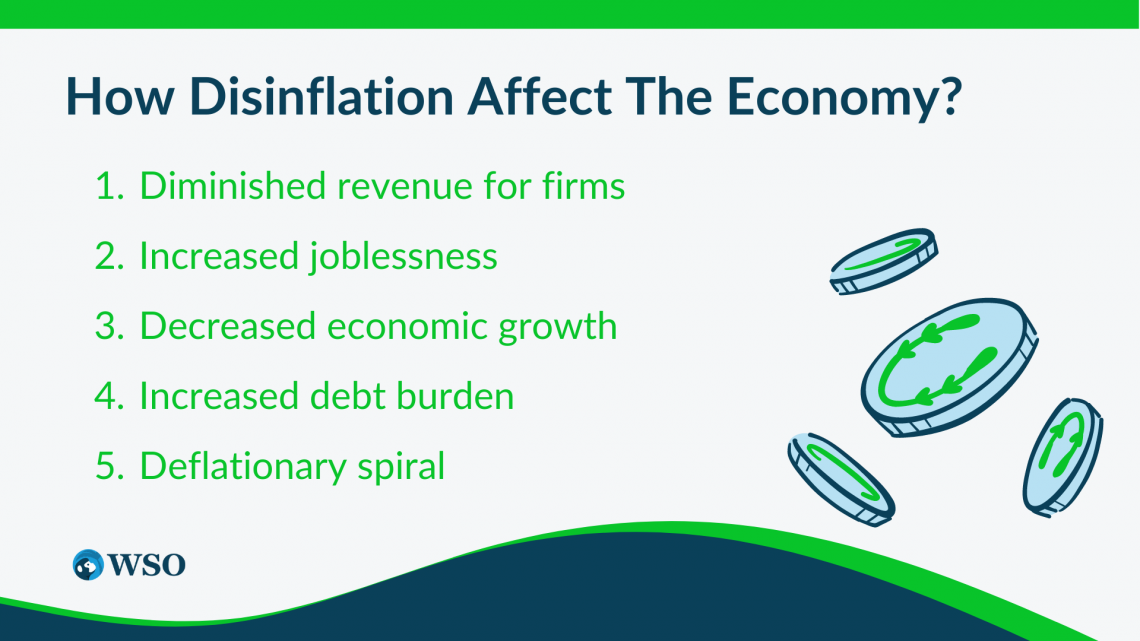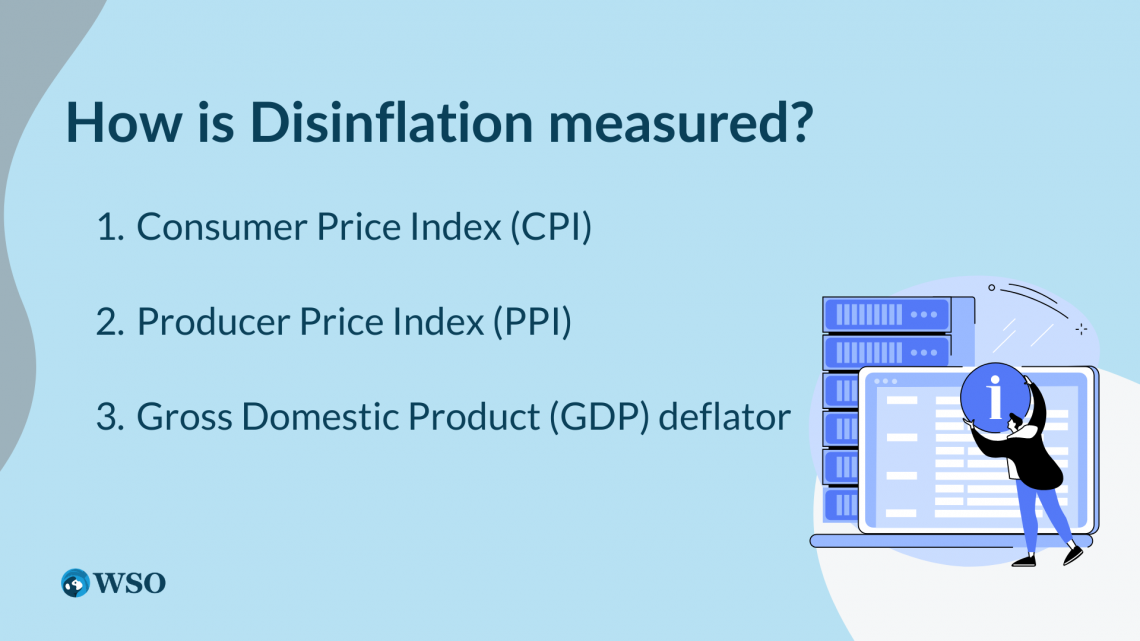Disinflation
Disinflation refers to a situation where the rate of price increases for goods and services slows down, indicating a deceleration in inflation and promoting a more controlled and stable economic environment.
What Is Disinflation?
Disinflation refers to occurrences where the inflation rate has temporarily slowed and is used to indicate situations where it has only slightly decreased.

It can assist with advancing economic stability and growth by expanding the purchasing power of consumers and organizations, decreasing the expense of borrowing, and working on international intensity.
Different factors can lead to disinflation, such as:
- Tight monetary policy
- A drop in aggregate demand
- Heightened competition
- Technical improvements
The Federal Reserve (Fed) frequently uses the term "disinflation" to refer to a period of declining inflation. Contrast it with deflation, which can be detrimental to the economy. Disinflation refers to the rate of change in the rate of inflation, as opposed to inflation and deflation, which talk about the direction of prices.
Inflation is a typical peculiarity that influences economies worldwide. It alludes to the rate at which the general price level of goods and services in an economy increases over the long haul.
While some inflation is good for economic growth, extreme inflation can have negative impacts, including a reduction in money's purchasing power and a decline in economic activity.
Key Takeaways
- Disinflation is the decrease in the inflation rate and is a beneficial economic condition.
- Tight monetary policy, decreased aggregate demand, increased competition, technological advancements, and exchange rate policy can lead to disinflation.
- Beneficial effects include increased purchasing power, improved international competitiveness, lower interest rates, and diminished inflation expectations.
- Negative effects of disinflation include reduced firm revenue, increased unemployment, and slower economic growth.
- Measured by CPI or PPI, disinflation is influenced by central banks using tools like interest rates. Challenges include delays and external factors affecting effectiveness.
Understanding Disinflation
Disinflation, or the gradual decrease in inflation, has both good and bad effects. It can boost purchasing power and encourage investment, but it can also lead to more unemployment and lower business revenues.
Hence, it is vital to adjust its positive and adverse consequences and carry out measures to accomplish it. Achieving a balance between these outcomes requires careful measures.
Note
Disinflation or decreasing inflation, affects purchasing power and employment. Policymakers balance its impact through measures like tight monetary policy, ensuring economic stability amidst global uncertainties.
In today's globalized economy and with the ongoing pandemic, it's crucial for policymakers to understand and address disinflation. The interconnected nature of economies makes it harder for individual countries to control inflation rates. .
Thus, it is a higher priority than at any time in recent memory for policymakers to comprehend its causes and effects and carry out measures to accomplish it.
Every one of these actions enjoys its benefits and weaknesses, and policymakers need to painstakingly assess every choice to decide the best strategy.
We shall thoroughly explore it in this article. We will investigate its causes and effects and the actions that can be taken to accomplish it. Toward the finish of this article, perusers will have an unmistakable comprehension of it and its part in advancing economic stability and growth.
Primary Causes of Disinflation
It alludes to a decrease in the inflation rate and can be brought about by different elements.

1. Tight monetary policy
One normal reason is tight monetary policy. At the point when national banks increase loan fees, diminish the money supply, or sell government securities, they can decrease inflation rates.
This is because these actions diminish the accessibility of money, making it more costly to get and spend, consequently decreasing aggregate demand and inflation.
2. Decreased aggregate demand
This can happen because of elements, for example, a decrease in shopper spending or business investment.
At the point when aggregate demand decreases, economic movement dials back, production decreases, and the general price level of goods and services can decrease.
3. Increased competition
When organizations face increased competition, they might diminish their prices to stay serious. This can prompt a decrease in the general price level of goods and services.
4. Technological advancements
Technological progress can also contribute to this phenomenon. Such advancements often enhance efficiency, reduce production expenses, and boost supply. Consequently, they may lead to a reduction in the overall price level of goods and services.
5. Exchange rate policy
When a nation's exchange rate appreciates, imports become less expensive, and exports become more costly, decreasing aggregate demand and inflation.
Supply-side policies, for example, liberation, tax cuts, and investment in infrastructure, can likewise prompt it by expanding production efficiency and lessening production expenses.
Disinflation VS Inflation
| Comparison Terms | Disinflation | Inflation |
|---|---|---|
| Definition | Disinflation denotes a deceleration in the pace of inflation,it results in an overall reduction in the inflation rate. | Inflation refers to the sustained increase in the general price level of goods and services over time. |
| Economic Impact | Disinflation, signaling a slowdown in price increases, contributes to economic stability by fostering a more predictable and manageable economic environment. | Inflation silently erodes purchasing power, diminishes the real value of money, and introduces uncertainty into economic landscapes. |
| Consumer Behaviour | Disinflation may lead consumers to postpone purchases in anticipation of lower prices ahead, potentially causing a negative impact on overall demand. | Inflation makes people want to spend quickly before prices go up, boosting overall demand. This rush in spending can stimulate economic activity and support businesses. |
| Debt Dynamics | Disinflation can increase the real burden of debt if nominal interest rates fail to adjust accordingly, placing increased financial pressure on debtors. | Inflation can reduce the real burden of debt by allowing future payments to be made with a less valuable currency, easing the financial strain on debtors. |
| Risk Perception | Disinflation is initially positive, signaling a slowdown in price increases, but excessive disinflation poses the risk of transitioning into deflation, with potential adverse effects on the economy. | Inflation is generally perceived negatively due to its eroding effect on purchasing power, and this intensifies when it transforms into hyperinflation causing economic instability. |
Disinflation VS Deflation
| Comparison Terms | Disinflation | Deflation |
|---|---|---|
| Definition | Refers to a decrease in the rate of inflation, meaning prices are still rising but at a slower rate. | Indicates a decrease in the general price level of goods and services in an economy, leading to negative inflation rates. |
| Price Movement | Prices continue to rise, but the rate of increase slows down over time. | Prices consistently decline, leading to a decrease in the overall purchasing power. |
| Impact on Consumers | Can have mixed effects on consumers, depending on factors such as wage growth and employment levels. While prices are still increasing, they do so at a slower pace, potentially easing cost-of-living pressures. | Generally viewed negatively as it can lead to decreased consumer spending, postponed purchases, and economic stagnation. Consumers may hold off on buying goods and services in anticipation of further price drops. |
| Monetary Policy Response | Central banks may adopt contractionary monetary policies, such as raising interest rates or reducing money supply growth, to slow down inflationary pressures. | Central banks typically implement expansionary monetary policies, including lowering interest rates and increasing money supply, to stimulate spending and counteract deflationary pressures. |
Note
It is critical to take note that disinflation can significantly affect the economy. Accordingly, policymakers need to painstakingly adjust its positive and adverse consequences while executing measures to accomplish it.
Benefits of Disinflation
It alludes to a decrease in the inflation rate and can significantly affect the economy. A portion of the beneficial outcomes of this include

1. Increased purchasing power
It can increase the purchasing power of consumers and organizations as the expense of goods and services decreases. This can prompt increased customer spending and business investment, easing economic growth.
2. Improved international competitiveness
It can work on a country's international competitiveness by decreasing the expense of exports. This can prompt increased demand for exports and an improvement yet to be determined in exchange.
3. Lower interest rates
This can result in lower interest rates, reducing the cost of borrowing for both businesses and individuals. Consequently, it may stimulate higher levels of investment and foster economic growth.
4. Diminished inflation assumptions
This can lead to a decrease in inflation expectations as consumers and businesses adjust to the new, lower inflation rate. Such adjustments can promote enhanced economic stability and consistency.
Drawbacks of Disinflation
Disinflation carries potential drawbacks alongside its intended benefits. Understanding these drawbacks is crucial for evaluating its overall impact on an economy.

1. Diminished revenue for firms.
It can decrease revenue for firms that can't lessen their costs, prompting decreased benefits and, possibly, employment misfortunes.
2. Increased joblessness
It can stimulate increased joblessness, assuming organizations lessen production and lay off laborers due to decreased demand.
3. Decreased economic growth
It can initiate decreased economic growth, assuming firms diminish investment and customer spending in light of decreased demand.
4. Increased debt burden
It can increase the debt burden for people and firms that have acquired at a higher inflation rate. This can prompt monetary troubles and, possibly, defaults.
5. Deflationary spiral
It can prompt a deflationary spiral, where consumers and organizations postpone spending fully, expecting further price decreases, driving further disinflation and economic stagnation.
Taking everything into account, it can affect the economy. Therefore, policymakers need to painstakingly adjust the adverse consequences while carrying out measures to accomplish the goals, considering the extraordinary conditions of every economy.
How is Disinflation measured?
It is measured by computing the rate of change in the general level of prices over a particular time frame. This rate of change is alluded to as the inflation rate, which happens when the inflation rate decreases.

There are a few techniques used to measure it.
1. Consumer Price Index (CPI)
The CPI is created using changes in the price of a predefined basket of goods and services. This is the most frequently utilized approach.
The still is up in the air by tracking the changes in the prices of a fixed basket of goods and services long term and is commonly used as a benchmark to measure it and inflation.
2. Producer Price Index (PPI)
One more technique used to measure it is the Producer Price Index (PPI), which measures the average change in prices by producers for their goods and services.
The PPI is often utilized to indicate inflationary pressures in the economy, as producers might give any expansion in their costs to consumers at higher prices.
3. Gross Domestic Product (GDP) deflator
Moreover, a few nations utilize elective measures to the CPI and PPI to measure it, like the Gross Domestic Product (GDP) deflator, which measures changes in the prices of all goods and services delivered in an economy. In addition, policymakers frequently utilize this measure to track inflation at the public level.
It is crucial to recognize that its assessment's precision depends on the validity of the information utilized to calculate inflation rates.
Note
Policymakers use GDP deflator for a comprehensive view, but accuracy depends on precise data. An outdated CPI basket may misrepresent living cost changes. In essence, inflation is measured by assessing the rate of price level change over time, using indices like CPI, PPI, or the GDP deflator.
For instance, assuming the CPI depends on an outdated or inaccurate basket of goods and services, the subsequent inflation rate may not accurately reflect changes in that frame of mind of living.
All in all, it is measured by computing the rate of change in the general level of prices over a particular time frame, utilizing measures like the CPI, PPI, or Gross domestic product deflator.
Disinflation and Monetary Policy
Disinflation and monetary arrangement are firmly intertwined, as central banks often utilize the monetary approach to impact and accomplish the inflation rate.
For instance, assuming the central bank accepts that inflation is excessively high, it might increase interest rates to lessen borrowing and spending, which can bring down aggregate demand and put a descending squeeze on prices, at last prompting it.
Then again, assuming that inflation is too low, the central bank might decrease interest rates to animate borrowing and spending, which can increment aggregate demand and put a vertical squeeze on prices, eventually prompting inflation.
Notwithstanding interest rate changes, central banks may likewise utilize other monetary arrangement instruments to accomplish it, like
- open market operations (buying or selling government securities),
- saving prerequisites (how much money banks should keep available),
- discount rate changes (the interest rate at which banks can borrow from the central bank).
Note
Central banks use monetary policy to manage inflation by adjusting interest rates and employing tools like open market operations. Challenges such as lags in policy impact and external factors can limit effectiveness. Yet, they remain crucial for navigating disinflationary strategies.
Nonetheless, there are moves and limits to utilizing monetary strategy to accomplish it. One test is that there can be a lag between the execution of monetary strategy and its consequences for the economy.
For instance, it might require a while or even a very long time for changes in interest rates to influence borrowing and spending patterns in the economy, which can postpone accomplishing its targets.
One more constraint is that external factors can constrain the viability of the monetary approach, for example:
- global economic circumstances.
- commodity prices,
- geopolitical risks.
For instance, in the event that there is an unexpected expansion in oil prices because of political instability in a significant oil-creating country, this can make inflation rise and make it harder for the central bank to accomplish it.
While the monetary approach can be a viable apparatus for accomplishing it, there are provokes and restrictions to its adequacy. Moreover, other external factors can likewise affect the progress of disinflationary strategies.
Conclusion
Disinflation, a reduction in inflation, results from factors like decreased demand or increased productivity. It impacts the economy by boosting consumer purchasing power but may lead to unemployment and reduced investment.
Central banks use monetary policy, adjusting interest rates and reserve requirements, to influence inflation. However, there are challenges, including delays in effects and external factors affecting its effectiveness.
Policymakers must carefully balance the benefits and drawbacks of monetary policy, considering its impact on different economic sectors and consumer groups. Individuals should be aware of its effects on their financial well-being, taking steps to mitigate risks, such as diversifying investments & managing debt.
In essence, a notable economic occurrence can greatly influence individuals and the broader economy. Understanding its causes and effects allows for informed decisions on monetary strategy and financial management.
Disinflation FAQs

It is a reduction in the rate of inflation, which implies that prices are increasing at a slower rate than previously.
Monetary strategy is a key instrument utilized by central banks to impact the rate of inflation and accomplish it.
Central banks utilize different devices, for example, changes in interest rates and hold necessities, to control the money supply and impact borrowing and spending patterns in the economy.
Nonetheless, the viability of monetary strategy can be constrained by external factors, for example, global economic circumstances and commodity prices.
Indeed, this might possibly prompt deflation, which is a supported lessening in the general price level of goods and services. If it proceeds to where prices are rising or falling in any event, deflation might happen.
People can shield themselves from its effects by differentiating their investments, dealing with their debt, and watching out for their costs for most everyday items.
This can remember effective financial planning for assets that have performed well during disinflation, like bonds and gold, and doing whatever it takes to square away exorbitant interest debt.
Moreover, people can search for the best arrangements for goods and services and search for ways of scaling back superfluous costs to assist with balancing the effect of any expansions in the cost for most everyday items.
Indeed, it might harm the economy if it prompts a reduction in demand and investment, which can prompt decreased economic growth and expanded unemployment.
Moreover, it can adversely affect debtors, like expanding the genuine worth of their debts, and can likewise influence the profitability of firms that depend on inflation for revenue growth.
Nonetheless, its effects can shift contingent upon the particular conditions and setting in which it happens.
Free Resources
To continue learning and advancing your career, check out these additional helpful WSO resources:









or Want to Sign up with your social account?